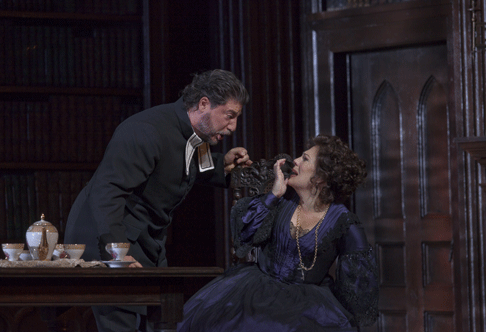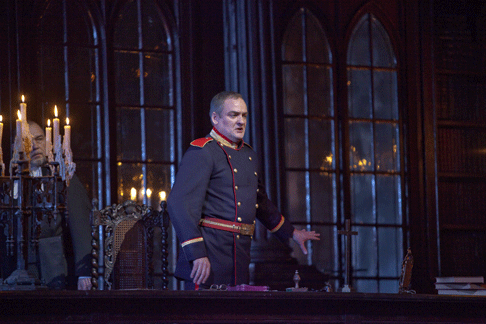You
can’t say the composer was at the height of his powers, because he got
better still. But there are stumbling blocks along any path to greatness, and
Stiffelio long appeared to be one of them.
Verdi had great hopes for the piece. He was gradually renouncing the
hackneyed traditions, seeking out new ways of expressing drama and new sorts of
drama for Italian opera to express. A play about the love life of an
evangelical minister — a married priest — struck him, as
it would strike any discerning Italian of the day, as deliciously original
— unfortunately, the Italian audience of 1850 simply found it weird. The
minister in question, Stiffelio, is not only married, he’s the lead tenor
in an Italian opera — stranger still. His wife has been seduced by a
bounder — which means, in any Italian opera, the tenor ought to kill the
fellow and perhaps his wife as well. The audience expected no less — on
the stage — though in private life, even then, married couples often
simply agreed to live apart with their subsequent partners and sometimes, in
Verdi’s time and circle, managed to divorce. But Stiffelio, as a man of
the cloth, much as he might want to kill, cannot do so. In the end, he
cannot even fail to forgive his wife, on the advice of Jesus in re the
matter of the woman taken in adultery and casting the first stone. The multiple
ironies were precisely what tickled Verdi and led him to compose
Stiffelio — but they went too far for the Italians, even the
sophisticated audience of Trieste (polyglot Austro-Hungarians, not peasants).
The opera failed. Verdi revised the score as Aroldo, but that only
removed the priestly tang that made the opera interesting to begin with.
Stiffelio, says Julian Budden, is “worthy to stand beside its
successor,” Rigoletto. Not exactly. Stiffelio’s a
sturdy piece, full of attractive numbers and fascinating scenes, great fun for
any lover of Verdi — but it is deeply flawed. Verdi threw out two early
acts of the play on which he based the opera, and the personality of his
villain went with them. The heroine’s motivations for her lapse are never
clear either — Verdi focuses on her morbid regret. Stiffelio is the only
rounded character, and him too we see only from the outside, never examining
his own feelings — as Rigoletto does, and Violetta, and Otello, and King
Philip, and even the Count di Luna and poor Master Ford. We see Stiffelio is
torn, we feel his pain — but Verdi doesn’t prove he is worth our
comprehension. The new musical language that would suit this new sort of drama
did not come to him — he was still inventing it.
The opera, then, is rough-hewn — vigorous but shallow, workmanlike.
Rigoletto, in contrast, is nothing of the sort — each of its
pieces fits into place as tightly as a jigsaw puzzle, the characters tell us
exactly as much as we need to know to care about their fate (or dislike them
intensely), and yet the music is never businesslike for want of beauty or
beautiful without attending to business. Stiffelio is an interesting
experiment; Rigoletto is a miracle.
 José Cura as Stiffelio and Sondra Radvanovsky as Lina
José Cura as Stiffelio and Sondra Radvanovsky as Lina
But good Rigolettos — and even decent Luisa Millers
— are so frequent in any Verdi-lover’s life that a run of
Stiffelio makes a pleasing variation. The Met’s production of
Stiffelio was originally given to permit Plácido Domingo to add
another tenor lead feather to his well-furbished cap. That ensured a sold-out
run, and the sets were handsome and distinguished enough to attest to
Domingo’s prestige, now that he merely conducts the opera. They are
handsome, gaunt dark-wood veneers and furnishings, a romantic graveyard with
ample space for duels, a stormy sky, a church somehow gothic on the outside
(Act II) but eighteenth century within (Act III). David Kneuss has revised
Giancarlo del Monaco’s direction, to the production’s decided
benefit — there is now something like human psychology on the stage. (Del
Monaco’s showy but often absurd stagings should be manhandled whenever
possible.)
Sondra Radvanovsky, who has impressed me as Luisa Miller, Leonora
(Trovatore) and Elena (in Vespri Siciliani), is a technically
accomplished singer with a Met-sized voice; too, she is a slim, handsome woman
and an ardent actress — a pleasant change in this role from the bovine
Sharon Sweet. Radvanovsky’s Lina is very fraught, on the edge of
depressive hysteria, which is as Verdi wrote her. Her voice has an interesting
vibrato and expresses passion well. But there is something about its color that
does not give pleasure. It is not a voice to relax with. She does not lack body
or sensuality, but she lacks velvet — there is a metal, clash, a
hardness, that makes her appearances thrilling but never ravishing.
José Cura sings Stiffelio. He is a pupil of Domingo’s and, like him, a
conductor, and like him, a tenor with a baritonal approach. This suits
Stiffelio better than most Verdi tenor roles — the part sits low, the
high lines come only at emotional climaxes, and Cura does emotional climaxes
well. His meditative moments are pleasing, his more passionate ones edge into
growling lack of clarity. He does not always thrill at moments designed to
thrill.
 Andrzej Dobber as Stankar
Andrzej Dobber as Stankar
Andrzej Dobber sings Stankar, a stock Verdi aggrieved father figure. When
Juan Pons (in the Eve Queler Aroldo) sang this music, in the word
“vergogna,” “shame,” you could hear the bile boiling up
in his throat. Dobber does not attain such realism, and either he or Maestro
Domingo got lost in his great Act III aria, but he sang with a clean, unforced
line and a fine though dry command of Verdian legato. You can’t do Verdi
without decent Verdi baritones; the world seems to be suffering a shortage, and
Dobber generally holds his own. Phillip Ens sang the rich if unvaried bass role
of Jorg most impressively, and Michael Fabiano made what could be made of the
half-sketched-in figure of Lina’s caddish seducer, Raffaele.
For students of Verdi, the orchestration of Stiffelio gives the
opera much of its interest. Maestro Domingo seemed to have trouble holding
things together during the overture, but thereafter, especially in the
concertato movements of the score and also in the rich scene-painting Verdi
bestows on the graveyard scene, he generally kept things together and brought
out the charming shades of this curious score. Still, singers sometimes had
trouble following him and I remain unconvinced that conducting is among his
many gifts.
John Yohalem
I returned to Stiffelio for the performance of January 19, the only cast change being the appearance - in her first major role at the Met - of Julianna Di Giacomo as Lina. Di Giacomo has a sweeter, more well-rounded soprano than Radvanovsky; if somewhat less powerful, still pleasurably audible over orchestra and ensemble. She is a young singer (early thirties), and lacks the full vocal body for later Verdi heroines just yet, but she has the intensity and the grace with ornament that his earlier roles demand. A short woman, on the plump side, she gave evidence of strong theatrical instincts, standing up for herself when Stiffelio suggests divorce, and sobbing on the ground at the conclusion of the opera in emotional exhaustion rather than stretching herself in theatrical supplication as Radvanovsky appeared to do. I had heard her before only in I Due Foscari for Opera Orchestra, an exciting night. She had a great success in Stiffelio and I would be eager to hear what she could do with Amelia Grimaldi, Luisa Miller, or the more dramatic roles of Donizetti.
Cura’s Stiffelio seemed muffled to the point of flatness, generally below the note, throughout Act II on this occasion, though his voice brightens at the top of his range. Dobber’s Stankar, his singing forceful and beautiful, gave the most constant pleasure of the night - plainly he and Maestro Domingo had sat down since last Thursday to work out the timing of that double aria. —J.Y.


